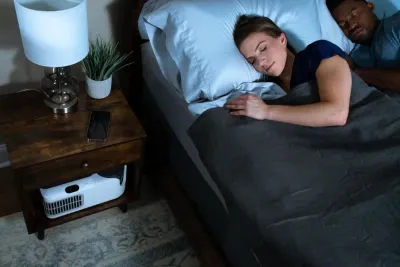Sharing a Bed: 10 Tips for Couples to Achieve Better Sleep
Ana Marie Schick: Resident Sleep Expert & Certified Health Coach • Aug 09, 2024

Key Takeaways
- Sleep Syncing: Aligning bedtimes can reduce disruptions and help both partners get deeper, more restorative sleep.
- Temperature Talks: One runs hot, the other cold? A bed cooling system like the Chilipad can keep everyone comfy with dual-zone climate control.
- Snore Solutions: If snoring’s the villain, try positional fixes, white noise, or separate bedding strategies to rescue your rest.
- Space Strategy: Don’t underestimate mattress size—a queen might be cozy, but a king gives you room to breathe.
- Routine Respect: A little compromise on screen time, lights, and sleep rituals goes a long way toward sleep harmony.
Imagine this: after a tiring day, you finally get into bed, looking forward to a peaceful night's sleep. You hear your partner's familiar restless movements as you settle under the covers.
It's not long before you fall asleep and find yourself awake again, attempting to get comfortable in a way that suits both your needs and your bed partner's. It could also be the ongoing struggle over the thermostat or the challenge of differing blanket preferences that leaves you tossing and turning. Does this situation sound familiar to you?
We're all aware of the significance of quality sleep for our general health and well-being. It plays a crucial role in impacting our mood, cognitive function, and even our physical and mental health. Yet, sharing a bed with a partner can sometimes make achieving restful sleep seem like an impossible dream.
The good news is that a good night's sleep is possible even when sharing a bed. You're in luck! We'll explore practical solutions to common challenges couples face, helping you both enjoy restful, rejuvenating sleep together.
Challenges of Sharing a Bed
Sharing a bed can be challenging for various reasons. Differences in sleep schedules and habits, temperature preferences, and physical movements can disrupt sleep quality for both partners.
Common issues such as snoring, tossing and turning, and differing comfort needs can make it difficult to find restful, uninterrupted sleep. However, understanding these common causes can pave the way for improvement.
If you and your partner are having trouble falling asleep or sleeping comfortably, explore these tips for better sleep:
Perfect Sleep, Perfect Temperature—for Both of You!
Sharing a bed doesn’t mean compromising on comfort. With the Chilipad Dock Pro, you and your partner can personalize your sleep temperatures on each side of the bed. Fall asleep faster and stay comfortable all night—together, but just the way you like it!
Invest in a Suitable Mattress
Choosing the right mattress size is important. If having trouble sleeping, upgrading to a larger mattress is one of the easiest and best ways to improve sleep quality when sharing a bed with a partner. A larger mattress provides more personal space, reducing the likelihood of disturbances caused by movement throughout the night.
With a bigger bed, both partners can move freely without bumping into each other or feeling cramped, which is especially valuable for those who tend to toss and turn throughout the night.
A queen-size mattress can be helpful, but a king-size bed will allow each person to have their own sleeping zone. This additional space can accommodate differing sleep positions, providing both partners can find a comfortable position without compromising personal space. A larger mattress can lead to better sleep quality and improved well-being for you and your bed partner.
Related Blog: What's the Difference Between a King and Cal King?
Separate Bedding
Can't agree on the thermostat? No sweat! Separate bedding can be a game-changer for couples with different temperature preferences. Individual blankets or duvets allow each person to adjust their comfort level without stealing the covers or waking their partner up with chills. This also minimizes nighttime tangles and sheet-pulling wars.
Address Snoring
Snoring can significantly disrupt your and your partner's sleep. It's important to have an open conversation with your partner about potential solutions. Consider trying earplugs, nasal strips, or even consulting a doctor if the snoring is severe.
Addressing snoring can improve the quality of sleep for both you and your partner. Learn more about sleep apnea and other common sleep disorders that can result in poor sleep.
Did You Know: Approximately 39 million U.S. adults suffer from obstructive sleep apnea (OSA) [1]
Experiment with Different Sleep Positions
Sharing a bed can be cozy but disruptive to sleep if you fight for covers or space. One potential solution is to experiment with different sleep positions. Some individuals crave cuddles, while others need room to sprawl out.
Sleep positions like spooning or back-to-back sleeping can accommodate these preferences. Side-sleeping by both partners can also minimize loud snoring disruptions that often occur when sleeping on the back.
Finding the best sleeping position where you don't feel crowded or tangled in each other's limbs leads to more comfort and fewer sleep disruptions. Discussing sleep positions opens communication and shows you're a team working towards more healthy sleep habits for both.
Remember, the best sleep position is the one that works for you as a couple, so be open to exploration and find that sleep sweet spot together!
Check out our blog to discover the names of common sleeping positions—and what each one reveals about your rest style.

Open Communication
Remember, good communication is crucial in any relationship and applies to your sleeping arrangements. Ignoring potential issues can lead to built-up resentment and frustration, so if there's anything that isn't working with how you and your partner sleep, it's important to have an open conversation about it.
Compromise may even be necessary. But don't worry; finding a happy medium doesn't have to be complicated. Stay mindful and respectful of your partner's sleep needs, such as temperature, noise, and light in the bedroom.
As long as you maintain open and honest communication, both of you can enjoy restful nights.
Related Blog: One popular approach for improving sleep quality among couples is the Scandinavian Sleep Method, which involves using two separate comforters instead of one shared blanket—helping to minimize disruptions caused by movements or temperature differences throughout the night.
Establish Bedtime Routines
Creating a consistent sleep routine can be beneficial. Couples who sync their sleep schedules have noted feeling more satisfaction in their relationship. This might be because a consistent sleep routine allows for more quality time together before bed, fostering connection and intimacy.
Talk openly about your ideal sleep needs and be willing to compromise if your preferences differ slightly. If your natural sleep schedules are way off, don't try to change overnight! Instead, make small adjustments to your bedtime in 15-minute increments over a week to help your body adjust.
Even on weekends, try to stick to a similar sleep schedule, allowing yourself an extra hour or two of sleep at most to avoid disrupting your rhythm. Doing this can help regulate your body's internal clock and promote better sleep quality.
Create a Calm and Comfortable Sleep Environment
Transform your bedroom into a tranquil sanctuary for sleep by making it quiet and relaxing. For better sleep, keeping the room dark, quiet, and cool is ideal. You can experiment with options, so both you and your partner can create a bedroom for maximum comfort.
Read More: Basic Cleaning Tips for Your Bedroom
Take control of the Lighting
Consider the use of blackout curtains to block out external light, establishing a dark bedroom environment that promotes better sleep. This simple step puts you in charge of your sleep environment.
Reduce Noise
Some options include using earplugs or a white noise machine. Both can help reduce disruptions and create a quieter sleep environment.
Regulate Room Temperature
Keep the room cool; a lower temperature can promote better sleep. We suggest an ambient room temperature of 65-68º F for optimal sleep. If you're looking to cool just your bed, our Chilipad bed cooling systems can help. There are numerous factors that can cause you to feel hot while sleeping at night, which can affect the quality of your sleep
Bonus: The Chilipad’s sleek, low-profile design blends seamlessly with your bedding setup—delivering powerful cooling without disrupting your bedroom’s aesthetic.
Choose Comfortable Bedding
Invest in top-notch pillows and bedding that meet your and your partner's comfort needs.
Respect Personal Space
Make sure the bed is big enough for both of you to move comfortably without disturbing each other. This consideration for personal space can significantly improve your sleep quality.
Sleep According to Your Own Schedule
Not all couples have the same sleep schedule, especially when one partner has irregular working hours. It's common for couples to have different chronotypes — one may be a morning person while the other is a night owl. Your chronotype, which aligns with your circadian rhythm, influences your natural preferences for wakefulness and sleep.
Note: Discover your chronotype, understand its impact on sleep, and optimize it for better health, whether you're an early bird or a night owl.
Adhering to your individual chronotypes can help you and your partner stay well-rested and energetic, even if your sleep patterns differ significantly. While it can be challenging if your chronotypes are opposites, you can still achieve good sleep when on different schedules. The key is to follow your sleep routine without disturbing your partner when entering or leaving the bed.

Create a Child-Free Bedroom
Creating a child-free bedroom can significantly enhance sleep quality for both you and your partner, though it may be challenging to implement. Children often disrupt sleep with their movements, noises, or needs during the night, leading to frequent interruptions.
Sleep Study: In a recent cross-cultural analysis of sleep habits in children aged 3–6 years, approximately 13.1% of U.S. caregivers reported sharing a bed with their child. [2]
By keeping them out of the bedroom, you can ensure a more peaceful and uninterrupted rest. This child-free space fosters a serene atmosphere conducive to sleep, helping both partners relax and fall asleep more easily. Additionally, having a private space for you and your partner promotes intimacy, strengthens your bond, and improves emotional well-being, contributing to better sleep quality.
While establishing and maintaining this boundary can be difficult, doing so encourages children to develop their sleep routines and independence, ultimately benefiting the entire family.
Consider a Sleep Divorce
Sometimes, even if you and your partner are compatible in many ways, you may struggle to sleep well together. This is a common issue and shouldn't be taken personally. If this sounds familiar, you might want to consider a "sleep divorce."
Despite its name, the concept is not as extreme as it may seem. Sleeping separately, even for a short time, can enhance the quality of sleep for both partners and aid in restoring disrupted sleep patterns.
For further insights into the concept of sleep divorce and its potential advantages for you, take a look at our blog, Navigating the Complexities of Sleep Divorce: Strategies for Success.
When to Contact Your Doctor
If you or your partner frequently struggle with sleep, you're not alone. Many people experience this, and it might be a good idea to see a doctor to check for any sleep disorders. These disorders can disturb the sleep of both the person affected and their partner, but remember, you're not alone in this.
Conditions like obstructive sleep apnea (OSA) or insomnia can cause significant physical and mental health problems. Seeking treatment early can help improve your sleep and overall well-being.
Conclusion
Sharing a bed with a partner can be challenging and lead to sleep deprivation and other sleep problems. But with effective communication, compromise, and a few adjustments, you can overcome these challenges and sleep better together.
By following the suggestions above, you can create an optimal sleep environment for both you and your partner, leading to improved sleep and a stronger, healthier relationship. Remember, a night of good sleep is essential for your overall health and well-being, so prioritize your sleep and reap the benefits of a well-rested mind and body.
Frequently asked questions
How to Sleep Better When You’re Sharing a Bed?
Sharing a bed shouldn’t mean sacrificing your shut-eye. Try these simple yet effective strategies to help both of you sleep better together:
- Sync your sleep schedules as much as possible.
- Use separate blankets to avoid the midnight blanket brawl.
- Choose a mattress with strong motion isolation.
- Add white noise to drown out snoring and tossing.
- Set bedroom boundaries—yes, even in bed.
- Keep devices out of the bed (no doomscrolling at midnight).
- Regulate sleep temperature with a dual-zone cooling pad like the Chilipad for personalized comfort.
What Are the Best Tips for Sharing a Bed Without Losing Sleep?
- Set a consistent sleep schedule
- Use separate blankets if needed
- Add white noise to mask movement or snoring
- Choose a mattress that isolates motion
- Communicate honestly about sleep preferences
- Unplug devices before bed
- Make room for intimacy and rest
Is It Normal for Couples to Not Share a Bed?
Absolutely. If sleeping side by side is wrecking your rest, you're not alone. It's called a sleep divorce—and it's more common than you think. According to the National Sleep Foundation, 1 in 10 couples sleep in separate rooms, and nearly 1 in 4 married couples opt for separate beds. Choosing sleep over snuggles isn’t a relationship red flag—it’s a smart move for better rest.
My Partner Runs Cold While I’m Having Night Sweats. Which Systems Offer Dual-Zone Temperature Control?
If your partner runs cold and you're battling night sweats, the Chilipad Dock Pro has you covered—literally. With dual-zone temperature control, each side of the bed can be set independently, from a cool 55°F to a cozy 115°F. No more thermostat wars—just custom comfort for both of you.
References
[1] “Sleep Apnea Statistics and Facts | NCOA.org.” National Council on Aging, 8 May 2024
[2] Mindell JA, Sadeh A, Kwon R, & Goh DYT (2013). Cross-cultural differences in the sleep of preschool children. Sleep Medicine, 14(12), 1283–1289. 10.1016/j.sleep.2013.09.002. View Study









